fuses PONTIAC GRAND PRIX 2008 Owners Manual
[x] Cancel search | Manufacturer: PONTIAC, Model Year: 2008, Model line: GRAND PRIX, Model: PONTIAC GRAND PRIX 2008Pages: 450, PDF Size: 2.64 MB
Page 93 of 450
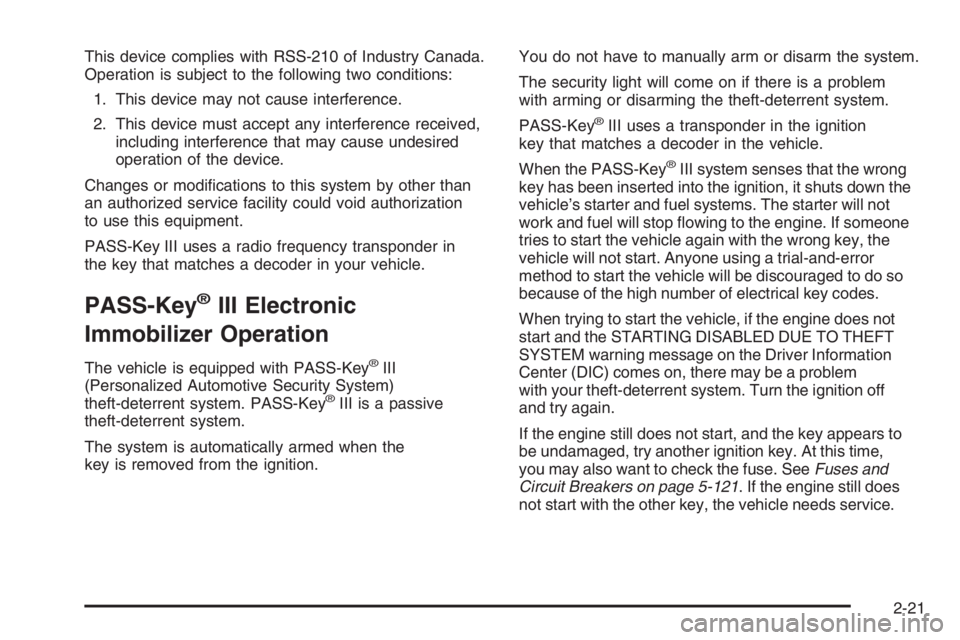
This device complies with RSS-210 of Industry Canada.
Operation is subject to the following two conditions:
1. This device may not cause interference.
2. This device must accept any interference received,
including interference that may cause undesired
operation of the device.
Changes or modi�cations to this system by other than
an authorized service facility could void authorization
to use this equipment.
PASS-Key III uses a radio frequency transponder in
the key that matches a decoder in your vehicle.
PASS-Key®III Electronic
Immobilizer Operation
The vehicle is equipped with PASS-Key®III
(Personalized Automotive Security System)
theft-deterrent system. PASS-Key
®III is a passive
theft-deterrent system.
The system is automatically armed when the
key is removed from the ignition.You do not have to manually arm or disarm the system.
The security light will come on if there is a problem
with arming or disarming the theft-deterrent system.
PASS-Key
®III uses a transponder in the ignition
key that matches a decoder in the vehicle.
When the PASS-Key
®III system senses that the wrong
key has been inserted into the ignition, it shuts down the
vehicle’s starter and fuel systems. The starter will not
work and fuel will stop �owing to the engine. If someone
tries to start the vehicle again with the wrong key, the
vehicle will not start. Anyone using a trial-and-error
method to start the vehicle will be discouraged to do so
because of the high number of electrical key codes.
When trying to start the vehicle, if the engine does not
start and the STARTING DISABLED DUE TO THEFT
SYSTEM warning message on the Driver Information
Center (DIC) comes on, there may be a problem
with your theft-deterrent system. Turn the ignition off
and try again.
If the engine still does not start, and the key appears to
be undamaged, try another ignition key. At this time,
you may also want to check the fuse. SeeFuses and
Circuit Breakers on page 5-121. If the engine still does
not start with the other key, the vehicle needs service.
2-21
Page 124 of 450
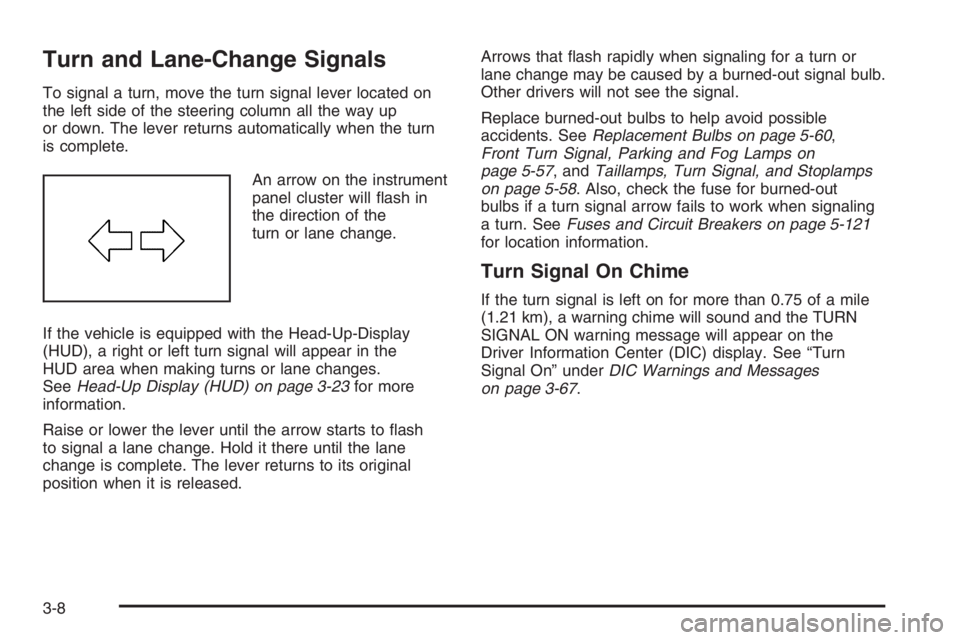
Turn and Lane-Change Signals
To signal a turn, move the turn signal lever located on
the left side of the steering column all the way up
or down. The lever returns automatically when the turn
is complete.
An arrow on the instrument
panel cluster will �ash in
the direction of the
turn or lane change.
If the vehicle is equipped with the Head-Up-Display
(HUD), a right or left turn signal will appear in the
HUD area when making turns or lane changes.
SeeHead-Up Display (HUD) on page 3-23for more
information.
Raise or lower the lever until the arrow starts to �ash
to signal a lane change. Hold it there until the lane
change is complete. The lever returns to its original
position when it is released.Arrows that �ash rapidly when signaling for a turn or
lane change may be caused by a burned-out signal bulb.
Other drivers will not see the signal.
Replace burned-out bulbs to help avoid possible
accidents. SeeReplacement Bulbs on page 5-60,
Front Turn Signal, Parking and Fog Lamps on
page 5-57, andTaillamps, Turn Signal, and Stoplamps
on page 5-58. Also, check the fuse for burned-out
bulbs if a turn signal arrow fails to work when signaling
a turn. SeeFuses and Circuit Breakers on page 5-121
for location information.
Turn Signal On Chime
If the turn signal is left on for more than 0.75 of a mile
(1.21 km), a warning chime will sound and the TURN
SIGNAL ON warning message will appear on the
Driver Information Center (DIC) display. See “Turn
Signal On” underDIC Warnings and Messages
on page 3-67.
3-8
Page 143 of 450
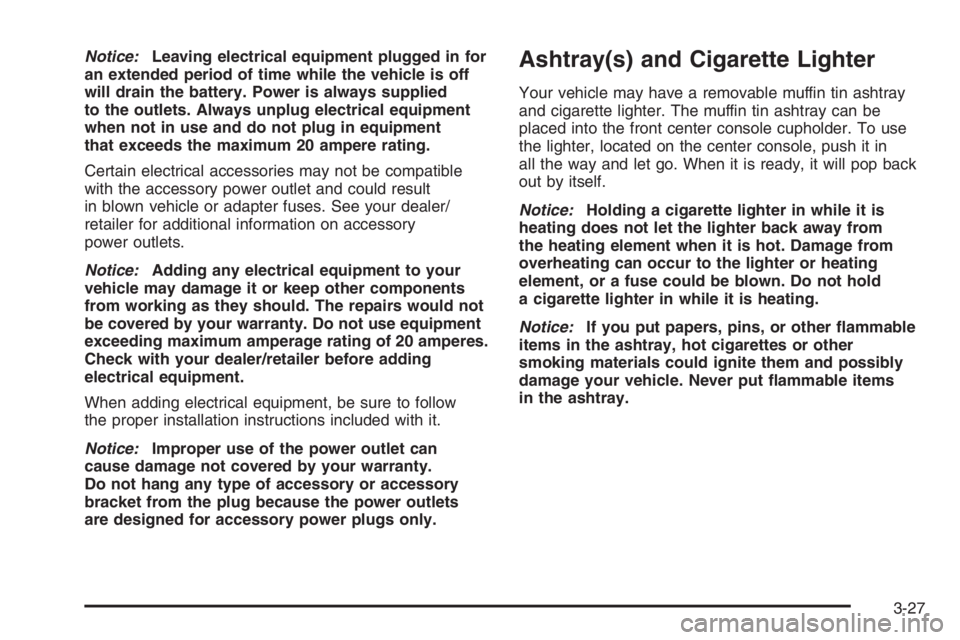
Notice:Leaving electrical equipment plugged in for
an extended period of time while the vehicle is off
will drain the battery. Power is always supplied
to the outlets. Always unplug electrical equipment
when not in use and do not plug in equipment
that exceeds the maximum 20 ampere rating.
Certain electrical accessories may not be compatible
with the accessory power outlet and could result
in blown vehicle or adapter fuses. See your dealer/
retailer for additional information on accessory
power outlets.
Notice:Adding any electrical equipment to your
vehicle may damage it or keep other components
from working as they should. The repairs would not
be covered by your warranty. Do not use equipment
exceeding maximum amperage rating of 20 amperes.
Check with your dealer/retailer before adding
electrical equipment.
When adding electrical equipment, be sure to follow
the proper installation instructions included with it.
Notice:Improper use of the power outlet can
cause damage not covered by your warranty.
Do not hang any type of accessory or accessory
bracket from the plug because the power outlets
are designed for accessory power plugs only.Ashtray(s) and Cigarette Lighter
Your vehicle may have a removable muffin tin ashtray
and cigarette lighter. The muffin tin ashtray can be
placed into the front center console cupholder. To use
the lighter, located on the center console, push it in
all the way and let go. When it is ready, it will pop back
out by itself.
Notice:Holding a cigarette lighter in while it is
heating does not let the lighter back away from
the heating element when it is hot. Damage from
overheating can occur to the lighter or heating
element, or a fuse could be blown. Do not hold
a cigarette lighter in while it is heating.
Notice:If you put papers, pins, or other �ammable
items in the ashtray, hot cigarettes or other
smoking materials could ignite them and possibly
damage your vehicle. Never put �ammable items
in the ashtray.
3-27
Page 169 of 450
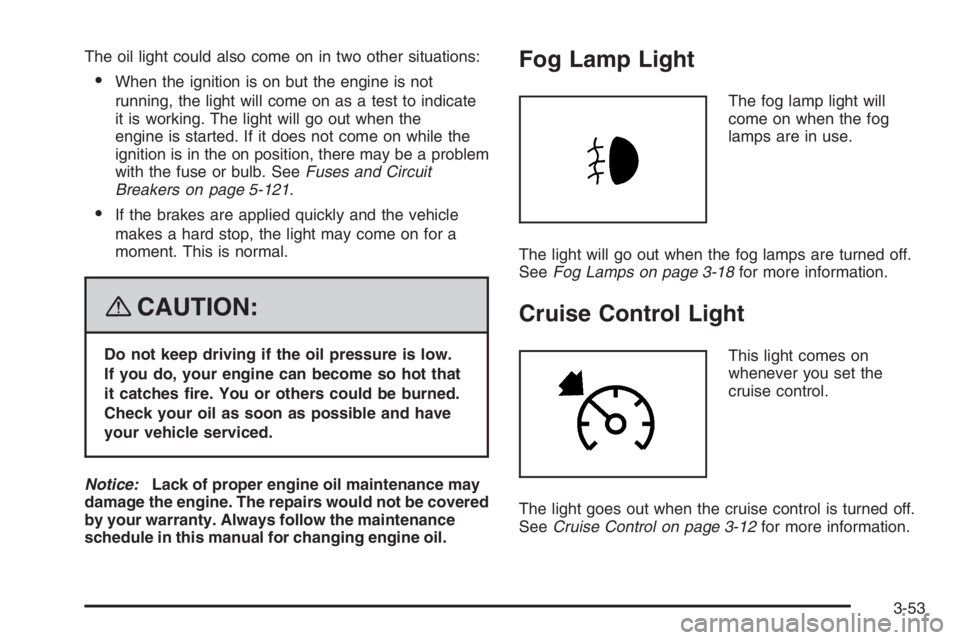
The oil light could also come on in two other situations:
When the ignition is on but the engine is not
running, the light will come on as a test to indicate
it is working. The light will go out when the
engine is started. If it does not come on while the
ignition is in the on position, there may be a problem
with the fuse or bulb. SeeFuses and Circuit
Breakers on page 5-121.
If the brakes are applied quickly and the vehicle
makes a hard stop, the light may come on for a
moment. This is normal.
{CAUTION:
Do not keep driving if the oil pressure is low.
If you do, your engine can become so hot that
it catches �re. You or others could be burned.
Check your oil as soon as possible and have
your vehicle serviced.
Notice:Lack of proper engine oil maintenance may
damage the engine. The repairs would not be covered
by your warranty. Always follow the maintenance
schedule in this manual for changing engine oil.
Fog Lamp Light
The fog lamp light will
come on when the fog
lamps are in use.
The light will go out when the fog lamps are turned off.
SeeFog Lamps on page 3-18for more information.
Cruise Control Light
This light comes on
whenever you set the
cruise control.
The light goes out when the cruise control is turned off.
SeeCruise Control on page 3-12for more information.
3-53
Page 272 of 450
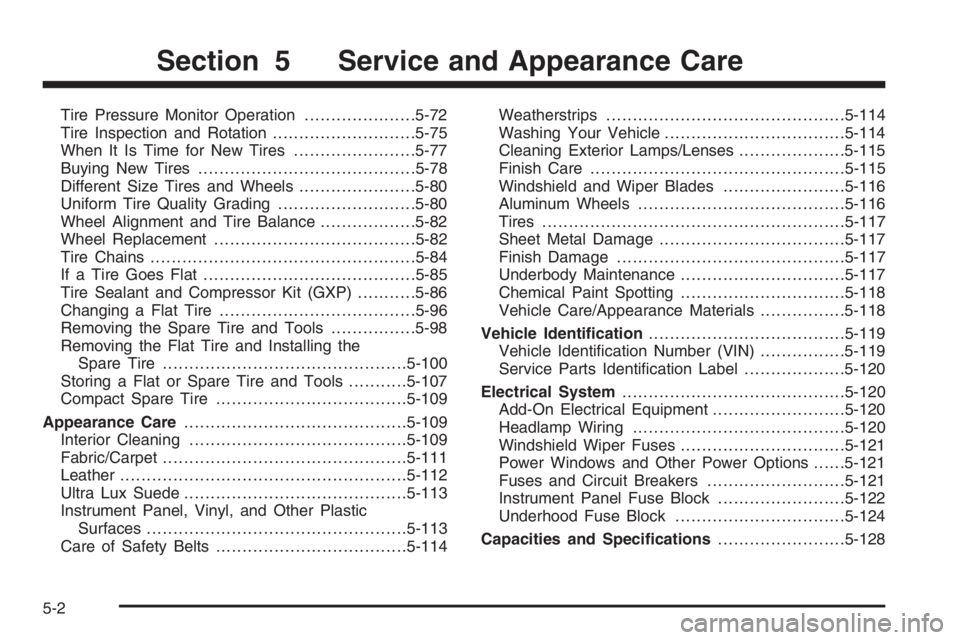
Tire Pressure Monitor Operation.....................5-72
Tire Inspection and Rotation...........................5-75
When It Is Time for New Tires.......................5-77
Buying New Tires.........................................5-78
Different Size Tires and Wheels......................5-80
Uniform Tire Quality Grading..........................5-80
Wheel Alignment and Tire Balance..................5-82
Wheel Replacement......................................5-82
Tire Chains..................................................5-84
If a Tire Goes Flat........................................5-85
Tire Sealant and Compressor Kit (GXP)...........5-86
Changing a Flat Tire.....................................5-96
Removing the Spare Tire and Tools................5-98
Removing the Flat Tire and Installing the
Spare Tire..............................................5-100
Storing a Flat or Spare Tire and Tools...........5-107
Compact Spare Tire....................................5-109
Appearance Care..........................................5-109
Interior Cleaning.........................................5-109
Fabric/Carpet..............................................5-111
Leather......................................................5-112
Ultra Lux Suede..........................................5-113
Instrument Panel, Vinyl, and Other Plastic
Surfaces.................................................5-113
Care of Safety Belts....................................5-114Weatherstrips.............................................5-114
Washing Your Vehicle..................................5-114
Cleaning Exterior Lamps/Lenses....................5-115
Finish Care................................................5-115
Windshield and Wiper Blades.......................5-116
Aluminum Wheels.......................................5-116
Tires.........................................................5-117
Sheet Metal Damage...................................5-117
Finish Damage...........................................5-117
Underbody Maintenance...............................5-117
Chemical Paint Spotting...............................5-118
Vehicle Care/Appearance Materials................5-118
Vehicle Identi�cation.....................................5-119
Vehicle Identi�cation Number (VIN)................5-119
Service Parts Identi�cation Label...................5-120
Electrical System..........................................5-120
Add-On Electrical Equipment.........................5-120
Headlamp Wiring........................................5-120
Windshield Wiper Fuses...............................5-121
Power Windows and Other Power Options......5-121
Fuses and Circuit Breakers..........................5-121
Instrument Panel Fuse Block........................5-122
Underhood Fuse Block................................5-124
Capacities and Speci�cations........................5-128
Section 5 Service and Appearance Care
5-2
Page 390 of 450
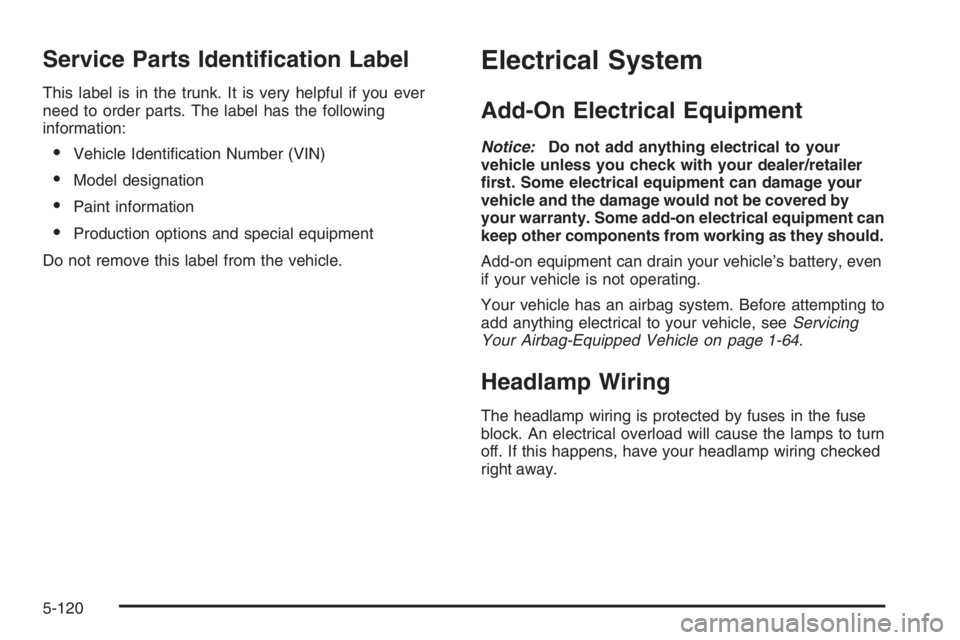
Service Parts Identi�cation Label
This label is in the trunk. It is very helpful if you ever
need to order parts. The label has the following
information:
Vehicle Identi�cation Number (VIN)
Model designation
Paint information
Production options and special equipment
Do not remove this label from the vehicle.
Electrical System
Add-On Electrical Equipment
Notice:Do not add anything electrical to your
vehicle unless you check with your dealer/retailer
�rst. Some electrical equipment can damage your
vehicle and the damage would not be covered by
your warranty. Some add-on electrical equipment can
keep other components from working as they should.
Add-on equipment can drain your vehicle’s battery, even
if your vehicle is not operating.
Your vehicle has an airbag system. Before attempting to
add anything electrical to your vehicle, seeServicing
Your Airbag-Equipped Vehicle on page 1-64.
Headlamp Wiring
The headlamp wiring is protected by fuses in the fuse
block. An electrical overload will cause the lamps to turn
off. If this happens, have your headlamp wiring checked
right away.
5-120
Page 391 of 450
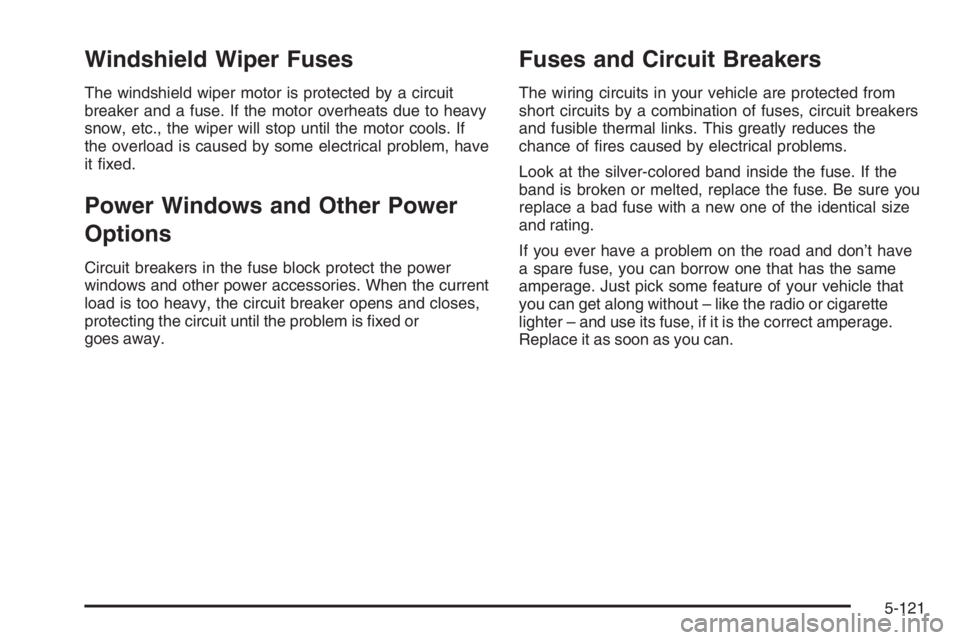
Windshield Wiper Fuses
The windshield wiper motor is protected by a circuit
breaker and a fuse. If the motor overheats due to heavy
snow, etc., the wiper will stop until the motor cools. If
the overload is caused by some electrical problem, have
it �xed.
Power Windows and Other Power
Options
Circuit breakers in the fuse block protect the power
windows and other power accessories. When the current
load is too heavy, the circuit breaker opens and closes,
protecting the circuit until the problem is �xed or
goes away.
Fuses and Circuit Breakers
The wiring circuits in your vehicle are protected from
short circuits by a combination of fuses, circuit breakers
and fusible thermal links. This greatly reduces the
chance of �res caused by electrical problems.
Look at the silver-colored band inside the fuse. If the
band is broken or melted, replace the fuse. Be sure you
replace a bad fuse with a new one of the identical size
and rating.
If you ever have a problem on the road and don’t have
a spare fuse, you can borrow one that has the same
amperage. Just pick some feature of your vehicle that
you can get along without – like the radio or cigarette
lighter – and use its fuse, if it is the correct amperage.
Replace it as soon as you can.
5-121
Page 392 of 450
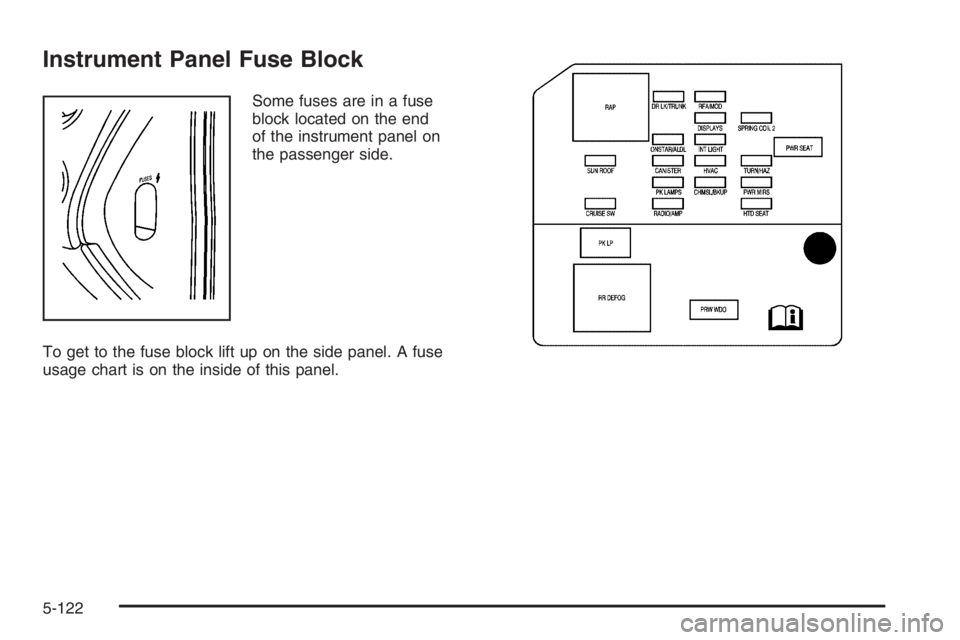
Instrument Panel Fuse Block
Some fuses are in a fuse
block located on the end
of the instrument panel on
the passenger side.
To get to the fuse block lift up on the side panel. A fuse
usage chart is on the inside of this panel.
5-122
Page 394 of 450
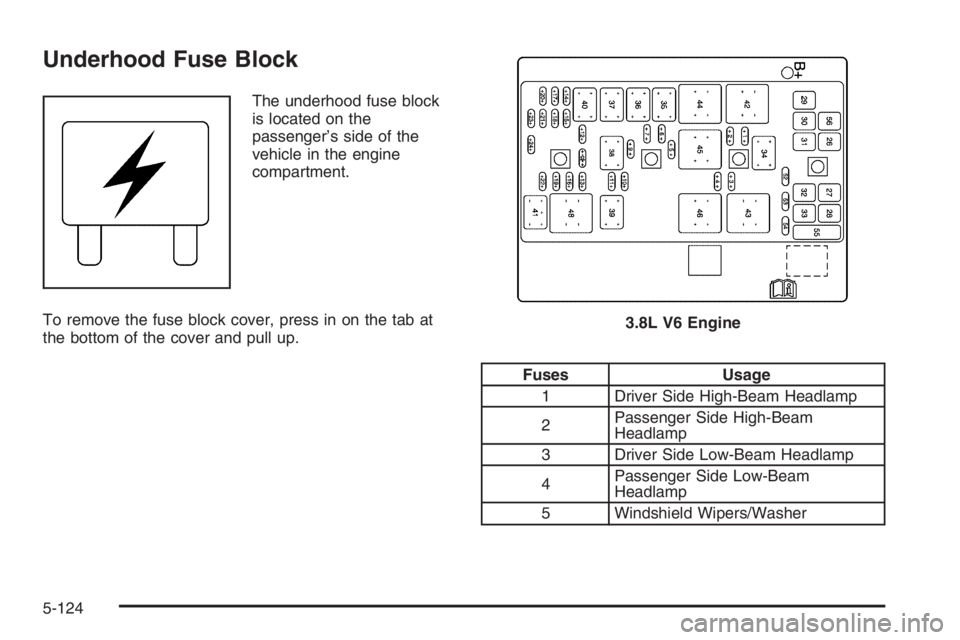
Underhood Fuse Block
The underhood fuse block
is located on the
passenger’s side of the
vehicle in the engine
compartment.
To remove the fuse block cover, press in on the tab at
the bottom of the cover and pull up.
Fuses Usage
1 Driver Side High-Beam Headlamp
2Passenger Side High-Beam
Headlamp
3 Driver Side Low-Beam Headlamp
4Passenger Side Low-Beam
Headlamp
5 Windshield Wipers/Washer
3.8L V6 Engine
5-124
Page 395 of 450
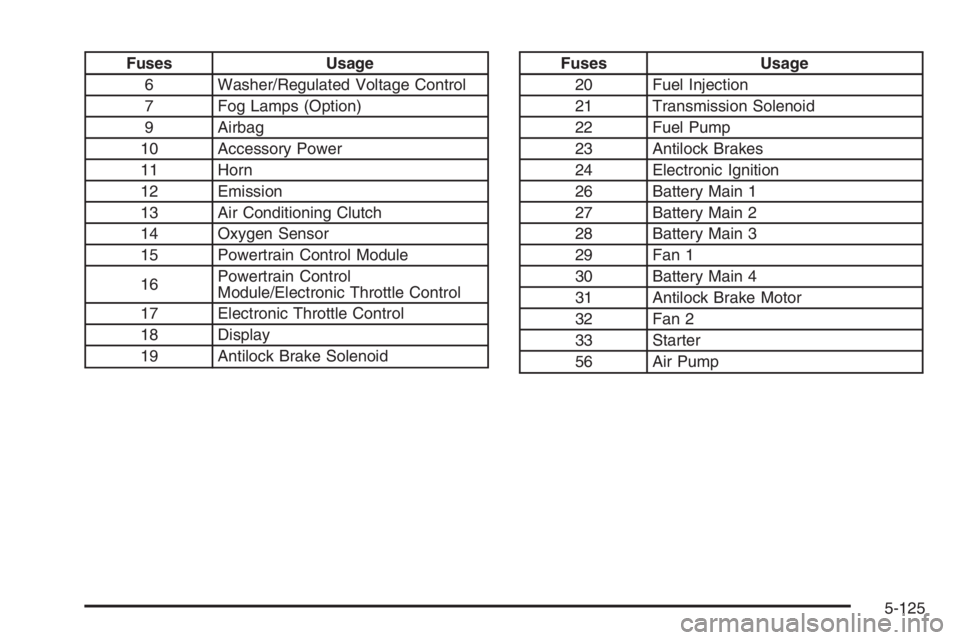
Fuses Usage
6 Washer/Regulated Voltage Control
7 Fog Lamps (Option)
9 Airbag
10 Accessory Power
11 Horn
12 Emission
13 Air Conditioning Clutch
14 Oxygen Sensor
15 Powertrain Control Module
16Powertrain Control
Module/Electronic Throttle Control
17 Electronic Throttle Control
18 Display
19 Antilock Brake SolenoidFuses Usage
20 Fuel Injection
21 Transmission Solenoid
22 Fuel Pump
23 Antilock Brakes
24 Electronic Ignition
26 Battery Main 1
27 Battery Main 2
28 Battery Main 3
29 Fan 1
30 Battery Main 4
31 Antilock Brake Motor
32 Fan 2
33 Starter
56 Air Pump
5-125